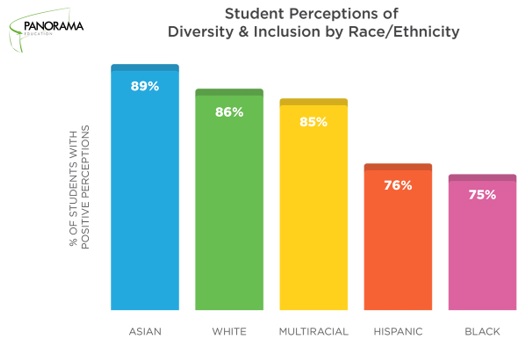Promoting Equality Diversity And Inclusion In Both Classroom And School Level: A Comprehensive Guide
24th January 2024

Every child deserves an equal right to education regardless of their background, race, or skin color. It’s every school leader and teacher’s responsibility to create a diversified classroom by promoting equality, diversity, and inclusion (ED&I) in the classroom.
According to landing.carolina.com survey, we can see that African and Hispanic students perceive school as less diversified than other race students.

Source: landing.carolina.com
Every school leader and teacher must consider creating an inclusive classroom environment by celebrating cultural diversity in the classroom, which will motivate every student to thrive in their life.
In this blog post, we will be exploring equality, diversification, and inclusivity in detail and effective strategies for promoting equality, diversity, and inclusion(ED&I) in the classroom.
Before moving to the topic, can we ask you a question? Do you follow us on Social Media? We regularly share upgraded educational content, tips, feedback, and more. Check us out by clicking the profiles here - Facebook / Twitter / LinkedIn / Pinterest / Instagram / YouTube
So, without any further delay, let’s get started.
What is Equality, Diversity, and Inclusivity?
Most of the time Equality, Diversity, and Inclusivity are considered to be related to each other, and most of the time it’s considered to be similar. But each term has a different meaning altogether, let’s get to know each term in the context of school which will help you in creating an inclusive classroom environment in primary school.
- Equality: Equality means that everyone in the classroom will be treated the same and fairly and will also get the same opportunities in the classroom. Every student is different and requires different types of levels of support depending on their unique need in the classroom and understanding every student’s unique needs teachers can help every one of them to give them equal opportunity to thrive in their academic journey.
- Diversity: Diversity means welcoming every student from different backgrounds and races. The application of the concept of diversity ensures celebrating cultural diversity in the classroom.
- Inclusion: Inclusion in the classroom means that every student’s uniqueness is celebrated in the classroom and they are not being left out for their unique behaviour or personality. This will ensure that every student feels a sense of belonging in the classroom.
The Importance of Equality, Diversity, and Inclusion
Promoting ED&I are crucial for both students and staff in educational institutions. Not only is it a legal requirement under the Equality Act 2010, but it also fosters an environment where everyone can learn, work, and thrive together. The Act protects individuals from discrimination, harassment, and victimization based on nine protected characteristics: age, disability, gender reassignment, marriage and civil partnership, pregnancy and maternity, race, religion or belief, sex, and sexual orientation.
To address bias and discrimination in the classroom and on school premises in a proper manner, school leaders and every school staff must not discriminate against, harass, or victimize students based on these characteristics in areas such as admissions, provision of education, access to benefits, facilities, or services, and exclusion or subjecting them to any other detriment. It is essential to take positive action and make reasonable adjustments to address the disadvantages faced by students with protected characteristics.
Promoting Equality, Diversity, and Inclusion (ED&I) at a School Level
Creating a culture that prioritizes equality, diversity, and inclusion in a whole school level is crucial for promoting ED&I effectively. Here are some strategies to embed these principles in the school's ethos:
1. Set Clear Goals and Expectations
School policies, including behaviour policies, anti-bullying policies, and staff codes of conduct, should clearly state the expectation that everyone is to be treated fairly and equitably. These policies should be communicated effectively to all stakeholders, ensuring they understand their responsibilities in creating an inclusive environment.
2. Prevent Negative Attitudes
Schools must have a clear policy regarding discriminatory behaviour and language. Negative attitudes should never be dismissed as mere banter. It is important to address any instances of discrimination promptly and effectively, fostering a culture of inclusivity and respect.
3. Supporting Strategies
Schools should have strategies in place to encourage individuals to come forward if they experience or witness anything that violates the school's commitment to equality, diversity, and inclusion. This includes providing support mechanisms such as counselling services or designated staff members who can address concerns and provide guidance.
4. Create an Inclusive Culture
Representations of diversity throughout the school can be a powerful tool for promoting inclusion and one of the most important aspects to ensure students from every background feel included in the classroom and in school as well.
According to recent study, it has been found out that 44% of public-school students identify as race other than white, which is a clear indication that there’s still a huge need of creating a inclusive environment for the students, so that they don’t feel excluded.

Source: zippo.co
This can be achieved through various means, such as displaying images and posters that celebrate diversity, building empathy and understanding in diverse classrooms, recognizing and celebrating religious and cultural events, and ensuring that the school's uniform policy is inclusive and respectful of students' diverse backgrounds.
5. Provide Effective Training
All staff should receive training on equality and diversity. This training should encompass explicit ED&I training as well as education on inclusion in all aspects of teaching, such as special educational needs and disabilities, safeguarding, mental health and wellbeing, and addressing bias and discrimination in the classroom. By equipping staff with the knowledge and skills to promote inclusivity, schools can create a more supportive environment for all students.
6. Include Inclusive Practices In The Curriculum
Inclusive practices should be reflected in the curriculum by explicitly teaching topics such as celebrating differences, challenging stereotypes, and addressing bias and discrimination in the classroom. These topics can be incorporated into various subjects, such as relationship education, and health education.
It is crucial to adopt a spiral curriculum approach, revisiting and building upon these topics throughout a student's educational journey.
Additionally, schools should ensure that the wider curriculum represents diversity positively. This can be achieved by including diverse characters in English texts, incorporating key figures who represent diversity in history, music, art, and physical education, and providing a range of perspectives that reflect the experiences of different cultures, ethnic groups, family structures, and individuals with disabilities or from LGBTQ+ communities.
7. Seek For Feedbacks
To ensure that the school is meeting the needs of its students and staff in terms of inclusivity, it is essential to actively seek feedback. This can be done through student and staff surveys, school councils, peer support groups, or dedicated feedback sessions. Welcoming suggestions and ideas for improvement fosters a sense of ownership and empowers individuals to contribute to the ongoing development of an inclusive school environment.
Promoting Equality, Diversity, and Inclusion (ED&I) in the Classroom
While a whole-school approach is crucial, promoting ED&I also happens at the classroom level. Here are some strategies to create an inclusive classroom:
1. Representation of Inclusivity in Learning Resources
Ensure that the resources used in the classroom reflect diversity. Evaluate existing resources through an inclusion lens and aim to improve their inclusivity. This can include selecting stories and books that represent a range of identities, cultures, and circumstances, providing dolls or small-world toys that challenge gender stereotypes and include diverse skin tones, and offering colouring materials that include a variety of skin tones.
When creating math or science problems, use inclusive pronouns, names, and scenarios that reflect diversity. There are plenty of resources for teaching about diversity and inclusion provider like- Wee-You-Things or TeachingBooks.net, which offer advice on inclusive resources that can further enhance classroom inclusivity.
2. Adapt Your Teaching Methodologies
Differentiate and personalize teaching and learning to meet the needs of all students, including those with special educational needs and disabilities (SEND). Use a variety of teaching and assessment methods, as well as accessible resources, to ensure that all students can access learning opportunities.
Consider individual learner needs and make reasonable adjustments to support students with SEND. This can include rephrasing questions, organizing classroom spaces to accommodate sensory needs, incorporating movement breaks, and providing materials in various formats.
3. Celebrate Diversity
Get to know your students and celebrate their uniqueness. Encourage students to explore and share aspects of their identities that make them unique. This could involve creating class displays or projects that highlight individual strengths, interests, or cultural backgrounds. By celebrating diversity, students feel valued and respected, fostering a sense of belonging.
4. Utilize Inclusive Language
Teachers play a crucial role in modelling inclusive language. Be mindful of the language used in the classroom, avoiding assumptions and stereotypes in everyday phrases. Opt for inclusive language that acknowledges and respects different family structures, cultural practices, and beliefs. Regularly reflect on the language used and strive to improve inclusivity.
Some of the best practices for inclusive language in the classroom are:
- Instead of saying "Sit down guys," use "Sit down everyone."
- Rather than addressing the class as "boys and girls," use "class" or "students."
By consciously choosing inclusive language, teachers create an environment where all students feel seen and valued.
Wrapping It Up
Promoting equality, diversity, and inclusion in the classroom is essential for creating a safe and supportive learning environment. By explicitly teaching about ED&I, modelling inclusive practices, and embracing diversity in the curriculum, schools can empower students to become respectful and inclusive individuals. Let's work together to create classrooms where every student can thrive and reach their full potential.
So, start by pursuing Early Years Care and Education Courses in Indonesia and work towards creating an inclusive classroom environment in primary school or in any educational institute.
We believe education should be accessible for everyone. That’s why we don’t charge for our blogs. Find the right course that will help you in your career with us, contact us at - 6531631068. You can mail us at act@asiancollegeofteachers.com.
Written By : Abhishek



